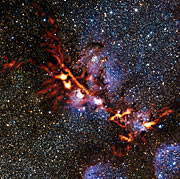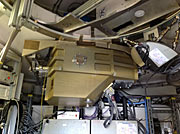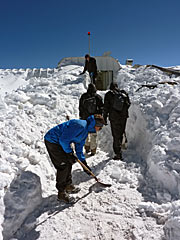Comunicato Stampa
Il freddo bagliore della formazione stellare
Prima luce della nuova potentissima fotocamera su APEX
25 Settembre 2013
Un nuovo strumento chiamato ArTeMiS è stato installato con successo su APEX (Atacama Pathfinder Experiment).
APEX è un telescopio di 12 metri di diametro ubicato ad altitudine elevata nel Deserto di Atacama, che opera a lunghezze d'onda millimetriche e submillimetriche, tra la luce infrarossa e le onde radio nello spettro elettromagnetico, fornendo un prezioso strumento per gli astronomi che vogliono guardare lontano nell'Universo. La nuova camera ha già prodotto una delle più spettacolari vedute della Nebulosa Zampa di Gatto.
ArTeMiS [1] è una nuova camera submillimetrica a grande campo di vista che costituirà una notevole aggiunta alla dotazione strumentale di APEX e aumenterà ulteriormente la profondità e il dettaglio che si possono osservare. La nuova matrice di rivelatori di nuova generalzione di ArTeMiS si comporta più come una CCD che come la generazione precedente di rivelatori. Questo permetterà di ottenere mappe del cielo a grande campo più in fretta e con più pixel.
L'equipe che ha installato ArTeMiS [2] ha dovuto combattere contro condizioni climatiche estreme per concludere il lavoro. La neve molto fitta sulla PIana di Chajnantor aveva quasi completamente sepolto l'edificio di controllo di APEX. Con l'aiuto del personale dell'OSF (Operation Support Facility) di ALMA e di APEX, l'equipe ha trasportato le scatole di ArTeMiS al telescopio tramite una strada di fortuna, evitando i cumuli di neve, e ha potuto installare lo strumento, posizionare il criostato e collegarlo nella sua ubicazione definitiva.
Per verificare lo strumento, l'equipe ha dovuto attendere un clima più asciutto poichè la luce submillimetrica che ArTeMiS osserva viene assorbita pesantemente dal vapor acqueo nell'atmosfera terrestre. Ma quando è arrivato il momento sono state effettuate delle osservazioni di prova di gran successo. Dopo le verifiche e le osservazioni di messa in servizio, ArTéMiS è già stata usata per diversi progetti scientifici. Uno dei suoi bersagli è stata la regione di formazione stellare NGC 6334 (o Nebulosa Zampa di Gatto) nella costellazione australe dello Scorpione. Questa nuova immagine di ArTeMis è molto migliore delle precedenti immagini di questa regione prese da APEX.
La verifica di ArTeMiS è stata completata e la camera tornerà a Saclay in Francia per installare nello strumento dei rivelatori supplementari. L'intera equipe è entusiasta dei risultati di queste prime osservazioni, un meravigliosa ricompensa per i molti anni di duro lavoro che non poteva essere raggiunta senza l'aiuto e il supporto del personale di APEX.
Note
[1] ArTeMiS sta per Architectures de bolomètres pour des Télescopes à grand champ de vue dans le domaine sub-Millimétrique au Sol, cioè matrice di bolometri per telescopi submillimetrici da terra a grande campo.
[2] L'equipe di installazione della CEA è composta da Philippe André, Laurent Clerc, Cyrille Delisle, Eric Doumayrou, Didier Dubreuil, Pascal Gallais, Yannick Le Pennec, Michel Lortholary, Jérôme Martignac, Vincent Revéret, Louis Rodriquez, Michel Talvard e François Visticot.
Ulteriori Informazioni
APEX è una collaborazione tra il Max Planck Institut für Radioastronomie (MPIfR), l'Osservatorio spaziale di Onsala (OSO) e l'ESO. La gestione di APEX a Chajnantor è affidata all'ESO.
L'ESO (European Southern Observatory, o Osservatorio Australe Europeo) è la principale organizzazione intergovernativa di Astronomia in Europa e l'osservatorio astronomico più produttivo al mondo. È sostenuto da 15 paesi: Austria, Belgio, Brasile, Danimarca, Finlandia, Francia, Germania, Gran Bretagna, Italia, Olanda, Portogallo, Repubblica Ceca, Spagna, Svezia, e Svizzera. L'ESO svolge un ambizioso programma che si concentra sulla progettazione, costruzione e gestione di potenti strumenti astronomici da terra che consentano agli astronomi di realizzare importanti scoperte scientifiche. L'ESO ha anche un ruolo di punta nel promuovere e organizzare la cooperazione nella ricerca astronomica. L'ESO gestisce tre siti osservativi unici al mondo in Cile: La Silla, Paranal e Chajnantor. Sul Paranal, l'ESO gestisce il Very Large Telescope, osservatorio astronomico d'avanguardia nella banda visibile e due telescopi per survey. VISTA, il più grande telescopio per survey al mondo, lavora nella banda infrarossa mentre il VST (VLT Survey Telescope) è il più grande telescopio progettato appositamente per produrre survey del cielo in luce visibile. L'ESO è il partner europeo di un telescopio astronomico di concetto rivoluzionario, ALMA, il più grande progetto astronomico esistente. L'ESO al momento sta progettando l'European Extremely Large Telescope o E-ELT (significa Telescopio Europeo Estremamente Grande), un telescopio da 39 metri che opera nell'ottico e infrarosso vicino e che diventerà "il più grande occhio del mondo rivolto al cielo".
La traduzione dall'inglese dei comunicati stampa dell'ESO è un servizio dalla Rete di Divulgazione Scientifica dell'ESO (ESON: ESO Science Outreach Network) composta da ricercatori e divulgatori scientifici da tutti gli Stati Membri dell'ESO e altri paesi. Il nodo italiano della rete ESON è gestito da Anna Wolter.
Links
Contatti
Michel Talvard
Project Manager for ArTeMiS / CEA
Saclay, France
Tel.: +33 1 6908 8352
E-mail: michel.talvard@cea.fr
Carlos De Breuck
ESO APEX Project Manager
Garching, Germany
Tel.: +49 89 3200 6613
E-mail: cdebreuc@eso.org
Richard Hook
ESO Public Information Officer
Garching bei München, Germany
Tel.: +49 89 3200 6655
Cell.: +49 151 1537 3591
E-mail: rhook@eso.org
Joerg Gasser (press contact Svizzera)
Rete di divulgazione scientifica dell'ESO
E-mail: eson-switzerland@eso.org
Sul Comunicato Stampa
| Comunicato Stampa N": | eso1341it-ch |
| Nome: | NGC 6334 |
| Tipo: | Milky Way : Nebula : Type : Star Formation Unspecified : Technology : Observatory : Instrument |
| Facility: | Atacama Pathfinder Experiment, Visible and Infrared Survey Telescope for Astronomy |






